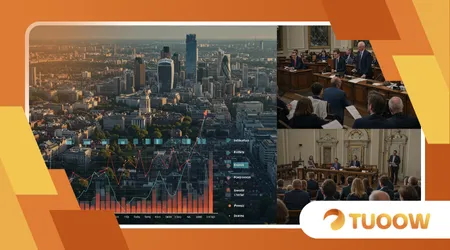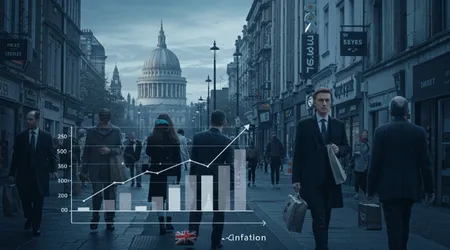Inflation in the UK: Trends and Government Response in 2025

Inflation weaves through every corner of the UK economy, shaping how families budget and businesses plan.
In 2025, it’s a topic that demands sharp focus. The Consumer Prices Index (CPI) sits at 2.2%, tantalizingly close to the Bank of England’s 2% target, yet stubborn pressures linger.
Global trade tensions, energy costs, and domestic policies keep inflation unpredictable.
This article dives into the latest trends, dissects government responses, and explores what’s at stake for households and businesses.
Why does inflation feel like a storm that never fully clears? Let’s unpack the forces at play and the strategies shaping the UK’s financial future.
The Current State of Inflation in 2025
The UK’s inflation rate has steadied at 2.2% in mid-2025, a sharp drop from 2022’s 11% peak. Falling energy prices and stable food costs drive this.
Yet, core inflation, excluding volatile items like fuel, hovers at 3.1%, signaling persistent pressures. Services inflation, tied to wages, remains sticky at 4.5%.
This cooling trend offers relief, but it’s fragile. For example, Sarah, a Manchester nurse, notices grocery bills easing but rent still climbing.
The Bank of England forecasts inflation rising to 2.5% by late 2025 due to energy bill hikes. Global trade disruptions, like US tariffs, add uncertainty.
++ UK Economic Growth Forecasts for 2025: Challenges and Opportunities
Households feel the squeeze unevenly. Lower-income families spend more on essentials, where price rises hit hardest.
The Office for National Statistics (ONS) reports food inflation at 2.8%, but specific items like dairy spike higher. Businesses, meanwhile, grapple with wage demands, pushing costs up.

Government Measures to Tackle Inflation
The Labour government, under Chancellor Rachel Reeves, has rolled out targeted measures to curb inflation.
A £40 billion tax package aims to fund public services without fueling demand. Business rates reform eases retailer costs, indirectly stabilizing prices.
Energy price caps, extended into 2025, shield households from volatile global markets. For instance, a Bristol family saves £150 annually due to these caps.
Also read: Corporate Profit Shifting to Low-Tax Jurisdictions Under Parliamentary Scrutiny
However, critics argue these are short-term fixes. Public sector pay rises, like the 5% teacher increase, risk stoking inflation further.
The government’s green energy push, with £22 billion for renewables, aims to reduce long-term energy costs. Yet, upfront investments may nudge prices up temporarily.
Posts on X highlight public frustration, with some calling for bolder tax cuts to ease household burdens.
A balanced approach defines Labour’s strategy. Reeves avoids austerity, focusing on growth to outpace inflation.
Critics, like economist John Redwood, warn that higher National Insurance could push prices up. The ONS notes a 0.3% monthly CPI rise in March 2025, suggesting caution.
Bank of England’s Role in Controlling Inflation
The Bank of England (BoE) wields interest rates to tame inflation. At 4.25% in mid-2025, rates are poised for a quarter-point cut in August.
This follows a 2.6% CPI in March, below the expected 2.7%. Lower rates could ease mortgage costs but risk overheating demand.
Charlie Bean, former BoE deputy governor, advocates a bolder half-point cut to counter trade war effects. Financial markets, per Yahoo Finance, see an 86% chance of a cut.
Read more: Select Committees Call for Stable Funding for BBC World Service
The BoE’s Monetary Policy Committee (MPC) eyes services inflation closely, as it reflects domestic pressures.
Mortgage holders like Tom, a London teacher, feel the pinch of high rates. A cut could save him £100 monthly, but savers lose out.
The BoE’s tightrope walk balances growth and price stability, with inflation forecasts at 2% by 2027.
The MPC’s cautious stance frustrates some. X posts from traders like @AlvaApp suggest four cuts in 2025, citing soft CPI data.
Yet, rising energy costs could derail this. The BoE’s data-driven approach avoids rash moves, prioritizing long-term stability.
Global Influences on UK Inflation
Global factors heavily shape UK inflation. US tariffs under President Trump, at 10% on imports, ripple worldwide.
The IMF predicts UK inflation at 3.1% in 2025, driven by higher import costs. Energy markets, disrupted by OPEC disputes, keep oil prices volatile.
China’s slowing exports, down 5% in Q1 2025, ease global commodity prices, offering the UK some relief. However, a stronger pound, up 2% against the dollar, raises import costs for retailers.
This hits consumers, as seen in a 3.8% grocery inflation spike in April.
Brexit’s lingering effects exacerbate pressures. Higher trade barriers with the EU increase costs for food importers. For example, a Kent grocer pays 10% more for Spanish oranges.
The IMF warns that global trade wars could push inflation higher, challenging UK policymakers.
Geopolitical risks, like Middle East tensions, threaten oil supply chains. A 5% oil price hike could add 0.2% to UK CPI, per the BoE.
The government’s diplomatic push for trade deals aims to mitigate these risks, but results are slow.
Impact on Households and Businesses
Households face uneven inflation effects. Lower-income families allocate 40% of budgets to food and energy, per the ONS, where price hikes hit hardest.
A single mother in Leeds cuts back on heating as bills rise 10%.
Businesses, especially SMEs, struggle with wage inflation. A Birmingham café owner raises prices 5% to cover staff costs, risking customer loss.
Retailers like Asda cut prices to stay competitive, but profit margins shrink, per Reuters.
Savings erode as inflation outpaces interest rates. A £10,000 savings account loses £200 in real value annually at 2.2% CPI.
Conversely, borrowers benefit from potential rate cuts, easing loan repayments.
The government’s £500 million household support fund helps vulnerable families with energy bills.
However, X users like @paullewismoney note that benefit rises lag inflation, leaving many poorer. Businesses demand tax relief to offset rising costs.
Long-Term Strategies for Stability
Looking ahead, the government bets on structural reforms to tame inflation.
Investment in green infrastructure, like offshore wind farms, aims to cut energy costs by 2030. These projects create jobs, boosting economic growth.
Education and skills training, backed by £5 billion, aim to reduce wage pressures by increasing productivity.
For example, a Sheffield tech firm trains workers in AI, cutting labor costs. Such moves could ease inflation over time.
Fiscal discipline is key. Reeves’ budget avoids excessive borrowing, which could spike demand and prices.
The IMF praises this, forecasting UK inflation at 2.2% by 2026. However, public spending must balance growth and restraint.
International cooperation is vital. Trade talks with the EU and US aim to lower import costs.
A successful deal could shave 0.5% off CPI, per the BoE. Yet, global uncertainties make this a gamble.

Practical Tips for Navigating Inflation
Households can counter inflation by budgeting smartly. Switching to cheaper supermarkets saves £200 annually, per Which?. Energy-saving habits, like LED bulbs, cut bills by 10%.
Businesses should hedge costs. Locking in supplier contracts now avoids future price hikes.
A Leeds bakery saves 8% by securing flour prices. Digital tools streamline operations, offsetting wage rises.
Investing in inflation-linked bonds protects savings. These yield 1% above CPI, preserving value.
For example, £5,000 invested grows with inflation, unlike fixed-rate accounts. Seek financial advice for tailored strategies.
Advocacy matters. Households can join consumer groups to push for fair pricing. Businesses should lobby for tax breaks via chambers of commerce. Collective action amplifies impact.
Data Snapshot: Inflation Trends
| Metric | March 2025 | Forecast Q4 2025 |
|---|---|---|
| CPI Inflation | 2.6% | 2.5% |
| Core Inflation | 3.4% | 3.1% |
| Services Inflation | 4.7% | 4.5% |
| Food Inflation | 3.0% | 2.8% |
Conclusion
The UK’s battle with inflation in 2025 is a complex dance of domestic policy and global forces. At 2.2%, CPI offers hope, but risks like trade wars and energy costs loom.
The government’s mix of tax reforms, energy caps, and green investments aims to stabilize prices while fostering growth.
The BoE’s cautious rate cuts balance household relief with economic restraint. For families and businesses, adapting to inflation means smart budgeting, strategic investments, and collective advocacy.
The path to the 2% target by 2027 is clear but not guaranteed. Staying informed and proactive is crucial in this ever-shifting landscape.
Frequently Asked Questions
Q: How does inflation affect my savings?
A: Inflation erodes savings’ real value. At 2.2%, £1,000 loses £22 annually. Inflation-linked bonds or high-yield accounts can help preserve value.
Q: What can businesses do to cope with rising costs?
A: Businesses can lock in supplier contracts, adopt digital tools, and lobby for tax relief. For example, a retailer saved 7% by securing bulk deals early.
Q: Will interest rates keep falling in 2025?
A: The BoE may cut rates to 4% by year-end, per market bets, but rising energy costs could pause this. Monitor MPC announcements for clarity.
